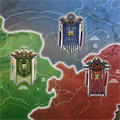Android: 自定义Tab样式
时间:2010-09-09 来源:朱宇华
1.制作4个9patch的tab样式,可参考android默认的资源
tab_unselected.9.png tab_selected.9.pngtab_press.9.pngtab_focus.9.png
这4个资源分别代表Tab的4种状态。
2.定义Tab的selector样式(就叫它tab_indicator.xml好了),将其放入drawable文件夹下,代码如下:
<?xml version="1.0" encoding="utf-8"?>
<selector xmlns:android="http://schemas.android.com/apk/res/android">
<!-- Non focused states -->
<item android:state_focused="false" android:state_selected="false" android:state_pressed="false" android:drawable="@drawable/tab_unselected" />
<item android:state_focused="false" android:state_selected="true" android:state_pressed="false" android:drawable="@drawable/tab_selected" />
<!-- Focused states -->
<item android:state_focused="true" android:state_selected="false" android:state_pressed="false" android:drawable="@drawable/tab_focus" />
<item android:state_focused="true" android:state_selected="true" android:state_pressed="false" android:drawable="@drawable/tab_focus" />
<!-- Pressed -->
<item android:state_pressed="true" android:drawable="@drawable/tab_press" />
</selector>
3.编写indicator的布局文件(不妨也叫tab_indicator.xml),将其放入layout文件夹下,代码如下:
<?xml version="1.0" encoding="utf-8"?>
<RelativeLayout xmlns:android="http://schemas.android.com/apk/res/android"
android:layout_width="0dip"
android:layout_height="64dip"
android:layout_weight="1"
android:layout_marginLeft="-3dip"
android:layout_marginRight="-3dip"
android:orientation="vertical"
android:background="@drawable/tab_indicator">
<ImageView android:id="@+id/icon"
android:layout_width="wrap_content"
android:layout_height="wrap_content"
android:layout_centerHorizontal="true"
/>
<TextView android:id="@+id/title"
android:layout_width="wrap_content"
android:layout_height="wrap_content"
android:layout_alignParentBottom="true"
android:layout_centerHorizontal="true"
style="?android:attr/tabWidgetStyle" mce_style="?android:attr/tabWidgetStyle"
/>
4.接下来就是在TabActivity中使用我们自己编写的Tab样式了:
// 首先获取TabWidget
mTabHost = getTabHost();
LinearLayout ll = (LinearLayout)mTabHost.getChildAt(0);
TabWidget tw = (TabWidget)ll.getChildAt(0);
然后用类似如下代码创建TabSpec,就大功告成了。
RelativeLayout tabIndicator1 = (RelativeLayout) LayoutInflater.from(this).inflate(R.layout.tab_indicator, tw, false);
TextView tvTab1 = (TextView)tabIndicator1.getChildAt(1);
tvTab1.setText("tab1");
mTabHot = mTabHost.newTabSpec("TAB_1")
.setIndicator(tabIndicator1)
.setContent(contentIntent);
相关阅读 更多 +










